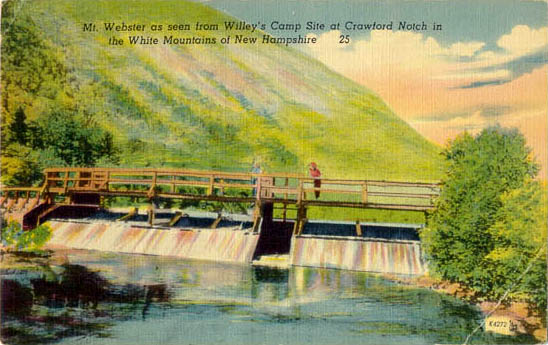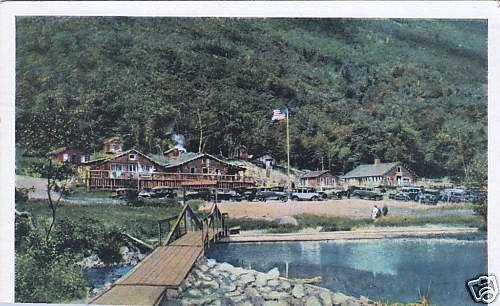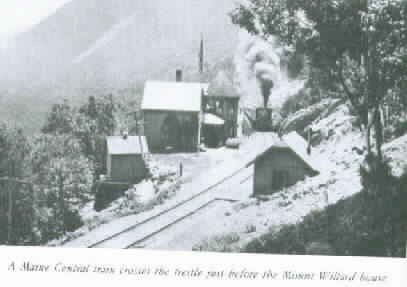|
Crawford Notch
OK, technically speaking, it is not part of Bartlett, but
Crawford Notch played a big role in putting Bartlett on the map,
beginning in 1771 when Timothy Nash and Benjamin Sawyer first
hauled a keg of rum up up through the rugged wilderness to
establish a trade route to Lancaster. When the railroad came
through in 1857 Bartlett prospered.
For a great reference book please refer to Harts Location in Crawford Notch by Marion L Varney - Published by Peter E. Randall in 1997 |
"The Devils Den" up the side of Mt. Willard, seen from the notch opposite the Silver Cascade, though as yet but imperfectly explored, deserves a passing notice. From below it appears like a dark hole in the steep cliff; and, though various attempts have been made to explore its shadowy secrets, from the day it was first
discovered by old Abel Crawford till 1850, it remained among the unvisited wonders. To
F. Leavitt, Esq., belongs the credit of succeeding, by means of a rope let down from the overhanging rock above, in the accomplishment of the daring enterprise of first visiting that spot. Fancy a man suspended over a dark gulf more than a thousand feet deep, by a rope let down from a ragged crag to a dark hole in the mountain, around the entrance of which were scattered the skulls and bones of animals, and you have a glimmering of the picture. Our hero lost all desire to enter that dismal cavern, and, kicking the rope, was again drawn up ; and since that time, by his descripiion, no explorer has been found with sufficient nerve and curiosity to make a second attempt. As there has never been discovered any possible means by which that den can be approached by foothold up the rock, and as the old Evil One has such daily business with mortal affairs, rather than believe that to be his abode, it appears more just to conclude that alone there the mountain eagle finds a solitary home.
Source: Historical relics of the White Mountains: Also, a concise White Mountain guide By John H. Spaulding 1862 ___________________________________________________ Here is another account of The Devils Den taken from The White Mountains: a handbook for travellers: a guide to the peaks, passes ...edited by Moses Foster Sweetser; 1886 The Devil's Den is a black-mouthed cavern on the S. side of the cliffs of Mt. Willard, and is plainly seen from the road. It is reported that Crawford visited it, many years ago, and found the bottom strewn with bones and other ghastly relics ; and marvellous stories of the supernatural were afterwards told about it. In 1856, however, the Den was explored by Dr. Ball, who was lowered down the cliff by .ropes. He found it to be 20 ft. wide and deep, and 15 ft. high, very cold and damp, but containing nothing remarkable or interesting During the State Survey of 1870, explorers were lowered to the Den by a rope 125 ft. long, but their discoveries did not repay the peril of the descent. 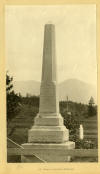 The
tall tales of Ethan Allen Crawford are mostly all true.
Read them HERE
Grave site
is just off the road to the Base Station of the Cog Railway.
Lucy is buried next to her husband. The
tall tales of Ethan Allen Crawford are mostly all true.
Read them HERE
Grave site
is just off the road to the Base Station of the Cog Railway.
Lucy is buried next to her husband.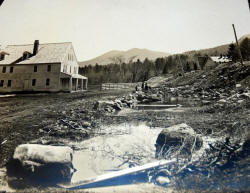 Rare 1870's photo of Crawford's Tavern at Bemis (left) and the Bemis Mansion on the right. Appears to be recently after a flood. The donor believes the picture was taken in the late 1870's. Photo Credit: Judith V. Hoell. Click the picture for a larger view. Photo below shows the same building in better times.  . .
. .
By John H. Spaulding
1862
The first goods brought up the Notch was a barrel of rum, which was given to Captain Rosbrook, by a merchant of Portland, on condition he would get it up through, the Notch. The captain made record, that after crossing the Saco river twenty-two times, with a horse and two poles, and several men, he succeeded in getting as much of the rum up as was not used in the enterprise. First produce carried down through the Notch was a barrel of tobacco, raised in Lancaster, by one Titus O. Brown. Thus, we see, rum and tobacco ranked here, where, among many good people of olden times, they were considered absolutely necessary, as first. But, thanks be to reformers, may the day not be far distant when an intemperate use of either shall be looked upon by the public, under the influence of moral persuasion, as an evil to be ranked in the same light with the follies of witchcraft! FIRST HOUSE IN THE NOTCH. The Willey House is the oldest building erected in the Notch. This was built in the year 1793, by a Mr. Davis, to accommodate the unfortunate storm-bound traveller, who, from curiosity, or on business, might dare the dangers of this wild pass. Then a little grassy meadow stretched along the bank of the Saco; tall rock-maples, and a towering mountain barrier, rose in the background from this little home of the pilgrim. How like a cool shadow of a great rock was this retreat among the frowning crags ! But the thundering avalanche came, and, since August 28th, 1826, the spirit of desolation has brooded over that fated spot. How lonely there is the dirge of the high wind, as it sweeps down that solitary chasm; and the wail of the sunset breeze, with the loud requiem of the on-rushing hurricane, is most mournful, for human bones are there palled in an avalanche's ruins.' Source: Historical relics of the White Mountains: Also, a concise White Mountain guide By John H. Spaulding 1862 Website Editor's note: The "Mr Davis" referred here may have been the father of Nathaniel Davis, who was the son in law of Abel and Hannah Crawford. Nathaniel Davis completed the Davis Path up Mt Crawford in 1845.  The Bemis House in Crawford Notch, Later Madam Morey's Inn Unique, and Now The Notchland Inn. It was constructed from granite quarried on the site over a ten year period beginning in 1860. Read the entire Dr. Bemis story at White Mountain History,Org. HERE (it will open in a new window)
HARTS LOCATION TOWN REPORT FROM 1937:
click
.As a side note to the reference "Madam Morey", Merle Burke of Bartlett worked for Florence Morey and said, "When he was twelve, I called Mrs Morey 'Madam' -- not knowing any better. Luckily she didn't hear me. But, after I said it, I thought my two Uncles, Pep and Jake and my grandfather Joe were going to snatch me bald-headed and pull my ears out. I learned a lesson that day! I read one time in the Conway Daily Sun, where someone said that she liked to be called 'Madam.' Well, I knew her for a long time and, I never knew of anyone ever calling her Madam to her face!!" REF: In Marion Varney's "Harts Location in Crawford Notch, New Hampshire's Smallest Town", published 1997, there is reference to the title, "Madam" on page 136: "She commenced her long reign as the Madam of Harts Location, as she preferred to be known, in 1928 when she was elected Town Clerk and Selectman." Since the author, Marion Varney, was a neighbor of Florence Morey there must be some truth to this statement.
More Crawford Notch on Page 2
More Crawford Notch on Page 2
More Crawford Notch on Page 2
|
Bits & Pieces
The Notch
Discovery:
In 1771 a Lancaster hunter, Timothy Nash, discovered what is now called Crawford Notch, while tracking a moose over Cherry Mountain. He noticed a gap in the distant mountains to the south and realized it was probably the route through the mountains mentioned in Native American lore. Packed with provisions, he worked his way through the notch and on to Portsmouth to tell Governor John Wentworth of his discovery. Doubtful a road could be built through the mountains, the governor made him a deal. If Nash could get a horse through from Lancaster he would grant him a large parcel of land at the head of the notch, with the condition he build a road to it from the east. Nash and his friend Benjamin Sawyer managed to trek through the notch with a very mellow farm horse, that at times, they were required to lower over boulders with ropes. The deal with the governor was kept and the road, at first not much more than a trail, was opened in 1775. Settlement: The Crawford family, the first permanent settlers in the area, exerted such a great influence on the development of the notch that the Great Notch came to be called Crawford Notch. In 1790 Abel Crawford, his wife Hannah (Rosebrook) and their growing family settled on the land granted to Sawyer and Nash, at what is now Fabyans in Bretton Woods. Two years later Eleazer Rosebrook, Hannah's father, and his family moved to Abel's homestead, who in turn, settled 12 miles away at the head of the notch in Hart's Location, for more "elbow room". Both families operated inns for the growing number of travelers through the notch. Abel's inn was the Mount Crawford House. The inn operated by the Rosebrooks was inherited by Abel's son Ethan Allen. In addition to being established innkeepers, the Crawfords were famous mountain guides that escorted visitors to the top of Mt. Washington. In 1819 Abel and Ethan Allen opened the Crawford Path, the footpath they had blazed to the summit. By 1840 horses could be on the trail. In 1821 Ethan Allen blazed a shorter route up Mt. Washington that is closely followed today by the cog railway. Railroad: Increasing tourism to the White Mountains generated interest in the building of a railroad through Crawford Notch. The construction of the railroad was considered a difficult engineering feat that was thought to be impossible by many. The railroad, built by Anderson Brothers of Maine, was opened in 1857 and ran from Portland, through the notch, to Fabyans, the area where Ethan Allen had operated his inn. Great difficulties and expenses were encountered due to the gain of 1,623 feet in elevation in the 30 miles between North Conway and Fabyans. There is an average rise of 116 feet per mile for the 9 miles between Bemis Station at the south end of the notch and Crawford Depot. Impressive Frankenstein Trestle, originally built of wood, and later replaced by steel, is 80 feet high and 500 feet long, while the Willey Brook Bridge is 100 feet high and 400 feet long. Crawford Notch State Park: Most of the land in Crawford Notch was acquired by the state of New Hampshire in 1913. It was the result of a bill passed by the legislature in 1922 aimed at rescuing the northern region of Hart's Location from excessive timber harvest. The bill failed to include the northern, most scenic part of the notch, which the state purchased in 1912 for $62,000. Almost 6,000 acres are included in the state park. The land extends on both sides of the highway to the summits of the mountains that border the Saco River Valley. In 1922 the Willey House clearing was leased to Donahue and Hamlin of Bartlett who built a cabin colony of peeled spruce logs for vacationers. More log buildings were added including rest rooms, restaurant and gift shop, but eventually the state took back the clearing for its own operations.
More Crawford Notch on Page 2
Willey Family During the fall of 1825 Samuel Willey, Jr. of Bartlett moved into a small house in the heart of Crawford Notch with his wife, five children, and two hired men. The first year the three men enlarged and improved the house which the family operated as an inn to accommodate travelers through the mountains on the desolate notch road. The little cluster of buildings was situated in the shadow of what is now called Mount Willey. In June, following a heavy rain, the Willeys were terrified when they witnessed a great mass of soil and vegetation, torn loose from the mountainside across the river, slide in a path of destruction to the valley floor. As a result, Mr. Willey built a cave-like shelter a short distance above the house to which the family could flee if a slide threatened their side of the valley. During the night of August 28, 1826, after a long drought which had dried the mountain soil to an unusual depth, came one of the most violent and destructive rain storms ever known in the White Mountains. The Saco River rose twenty feet overnight. Livestock was carried off, farms set afloat, and great gorges were cut in the mountains. Two days after the storm, anxious friends and relatives penetrated the debris-strewn valley to learn the fate of the Willey family. They found the house unharmed, but the surrounding fields were covered with debris. Huge boulders, trees, and masses of soil had been swept from Mt. Willey's newly bared slopes. The house had escaped damage because it was apparently situated just below a ledge that divided the major slide into two streams. The split caused the slide to pass by the house on both sides leaving it untouched. Inside, beds appeared to have been left hurriedly, a Bible lay on the table, and the dog howled mournfully. Mr. and Mrs. Willey, two children, and both hired men were found nearby, crushed in the wreckage of the slide. The bodies were buried near the house and later moved to Conway. Three children were never found. The true story of the tragedy will never be known. Poets and writers have conjectured many possibilities. Perhaps the family, awakened by a threatening rumble, fled from the house to their cave, and were caught in one stream of the slide. It seems more likely the Willeys started to climb the slope of the mountain to escape the rising floods and were caught in the landslide. Whatever the circumstances of the tragedy, it has endowed this part of the White Mountains with a legend enhanced by the awesome crags which rise guardians over the site of the former Willey home. Following the tragedy, an addition was built onto the house which was operated as an inn until it burned in 1898. Source Material: NH State Parks Dept |
